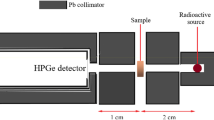The chemical and structural properties of cement compounds, containing radwaste simulators, after exposure to γ-radiation and electrons to absorbed dose 100 MGy are examined. It is shown that the phase composition and surface morphology of samples of cement compounds do not change much and the chemical stability remains satisfactory.
Similar content being viewed by others
References
A. P. Varlakov, V. V. Kapustin, G. A. Varlakova, et al., “Effect of radiation loads characteristic of high-level radwaste on the properties of a cement matrix,” Radioakt. Otkh., No. 1(2), 89–96 (2018).
A. P. Varlakov, A. A. Stallions, V. G. Petrov, et al., “The behavior of the cement matrix under radiation loads,” Vopr. Rad. Bezopasn., No. 3, 13–20 (2018).
A. Varlakov, A. Zherebtsov, V. Kapustin, et al., “Characteristics of cement compounds after irradiation up to doses typical for high level radioactive waste,” in: 3nd Int. Symp. on Сement-Based Materials for Nuclear Waste, NUWCEM 2018, Avignon, France, Oct. 24–26, 2018, p. 103.
GOST R 51883-2002, Cemented Radioactive Wastes: General Technical Requirements, Izd. Standartov, Moscow (2002).
J. Pachner, Assessment and Management of Ageing of Major Nuclear Power Plant Components Important to Safety: Concrete Containment Buildings, IAEA-TECDOC-1025, IAEA, Vienna (1998).
Y. Kitsutaka and K. Matsuzawa, “The effect of gamma radiation on the fracture properties of concrete,” in: Fracture Mechanics of Concrete and Concrete Structures – Recent Advances in Fracture Mechanics of Concrete, Korea Concrete Institute, Seoul, May 23–28, 2010, pp. 61–64.
S. E. Vinokurov, Yu. M. Kulyako, O. M. Slyuntchev, et al., “Low-temperature immobilization of actinides and other components of high-level waste in magnesium potassium phosphate matrices,” Nucl. Mater., 385, 189–192 (2009).
GOST R 52126-2003, Radioactive Wastes: Determination of the Chemical Stability of Solidified High-Level Waste by Continuous Leaching, Izd. Standartov, Moscow (2003).
M. N. Sabodina, S. N. Kalmykov, Yu. A. Sapozhnikov, et al., “Neptunium, plutonium and 137Cs sorption by bentonite clays and their speciation in pore waters,” Radioanal. Nucl. Chem., 270, 349–355 (2006).
S. A. Khan, “Sorption of the long-lived radionuclides cesium-134, strontium-85 and cobalt-60 on bentonite,” Radioanal. Nucl. Chem., 258, 3–6 (2003).
N. Mobasher, S. A. Bernal, H Kinoshita, et al., “Gamma irradiation resistance of an early age slag-based cement matrix for nuclear waste encapsulation,” Mater. Res., 30, No. 9, 1563–1571 (2015).
Author information
Authors and Affiliations
Corresponding author
Additional information
Translated from Atomnaya Énergiya, Vol. 127, No. 6, pp. 328–331, December, 2019.
Rights and permissions
About this article
Cite this article
Zherebtsov, A.A., Kapustin, V.V., Varlakova, G.A. et al. Chemical Stability and Structural Characteristics of Cement Compounds with Radwaste Simulators after Ionizing Radiation Exposure. At Energy 127, 362–366 (2020). https://doi.org/10.1007/s10512-020-00637-z
Received:
Published:
Issue Date:
DOI: https://doi.org/10.1007/s10512-020-00637-z



